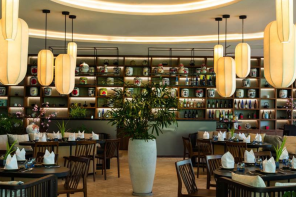When it comes to a restaurant fit-out, a lot of time is dedicated to the floor plan. What kind of seating suits your cuisine? Will it be all traditional tables with white tablecloths, shared tables with an eclectic selection of vintage chairs, or private booths?
Much of it comes down to the style of establishment. A tapas restaurant may suit long, communal tables with stools, while the same wouldn’t work with traditional gueridon service. Now, as distinctions between dining styles are becoming increasingly blurred and the way in which consumers eat out is rapidly shifting, many restaurants are adopting a mixed approach to their seating plans – and stools are playing a major role.
Tim Suckling is the director of Harrows, a New Zealand owned and operated hospitality furniture manufacturer and supplier. He said that as dining habits have changed, so too has the way restaurants choose to seat their customers.
“We are seeing a shift away from the traditional pub environment to more of a casual eats environment, with venues needing to provide more extensive food offerings,” he explained. “There is also a shift as described above to more venues wanting to include a variety of zones, so a café may add a leaner with stools as a type of waiting zone to accommodate their takeaway customers and zone them separately to their dine-in customers.”
Traditionally stools are regarded as casual furniture, servicing the bar industry, but their application has grown increasingly broad across different venue types.
“While still very relevant and popular on the bar side of things, a lot more gastro style venues are incorporating stool height dining into their venues,” Suckling said. “Certain stool designs can be a great option for takeaway outlets and quick eats venues thanks to their small footprint and robust construction, accommodating high traffic in compact areas. While it's less common to see them in fine-dining environments, a luxuriously upholstered stool with back and arms can be a great addition to a fine dining venue. There is definitely more demand for stools with backs than there has been previously.”
Stools can be an aesthetic choice, as in Al Brown’s Federal Delicatessen, which aims to replicate a New York deli, or Satya Spice & Chai, which cultivates a dark and rustic feel with low stools and hessian wall coverings. Stools also offer a way of layering the restaurant, offering customers further away from windows the ability to see out and over the dining crowd.
“There has been a shift for venues to layer and zone their layouts using various heights, so we see more venues using a variety of stool heights to create a tiered effect,” said Suckling. “Traditionally the higher 750mm stool was used for hospitality purposes, but now it is a blend of 750 high and 650 high stools, combined with traditional chair seating.”
An example of this is Intai in Christchurch, where owners Simon and Lisa Levy have opted for a split seating arrangement. A ring of stools has diners facing the bar and the kitchen, allowing an unobscured view into the kitchen, while windows are lined with standard chairs and tables. The stools are far from traditional rickety bar seating – they are plush, grey and comfortable, more elevated chairs than what would normally be considered a stool.
Beyond simple convention, though, seating can impact diner behaviour. Reservation website Resy found that customers will spend an average of 85 minutes in a venue if seated at a bar, compared to 105 minutes if seated at a traditional table. However, the same survey also showed that the total bill for those in bar seating is often less, finding that customers at the bar order more smaller plates or appetisers rather than spending money on big-money mains.
“While stools can be selected and customised as a great experience for fine dining, the general expectation is that you turn tables quicker in a stool height dining environment versus a chair dining height,” Suckling said.
A study conducted by Cornell University found that patrons sitting at bar-style seating spent an average of 44 minutes in the restaurant and spent an average of US$17 per person. While the spending was lower compared to booths and banquette seating, the time spent was also significantly shorter. This was echoed in a recent investigation by the Wall Street Journal, with some New York restaurants admitting that they could make 50 percent more profit with bar seating, as they offer quicker turnover and take up less space.
The most important thing, according to Suckling, is to make sure your seating is fit for purpose.
“Consider your customer base – what height is best for them? Do they need to be stackable if you want your staff to store them away regularly? Is it robust enough, or delicate enough to fit your client base and your story? Do you want your diners in and out, or do you need a stool with a back to keep them comfortable for a longer time?”






